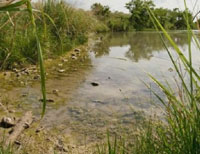
The U.S. Department of Agriculture (USDA) Natural Resources Conservation Service (NRCS) in Texas is accepting applications submitted for the National Water Quality Initiative (NWQI) before the May 30, 2025, batching period deadline.
NRCS has funding available for projects within the four identified priority Hydrologic Unit Code-12 (HUC-12) watershed areas: Aransas River, Big Elm Creek, Lake Lavon and Lampasas River.
- The Aransas River priority area consists of 12 HUC-12 watersheds in Bee, Refugio and San Patricio counties.
- The Big Elm Creek priority area consists of seven HUC-12 watersheds in Bell, Falls, Milam and McLennan counties.
- The Lake Lavon priority area consists of nine HUC-12 watersheds in Grayson, Fannin, Collin and Hunt counties.
- The Lampasas River priority area consists of eight HUC-12 watersheds in Lampasas and Burnet counties.
National Water Quality Initiative
The purpose of NWQI, which is offered through the Environmental Quality Incentives Program (EQIP), is to work with agriculture producers and landowners to improve water quality. NWQI is designed to help individual agriculture producers take actions to reduce runoff of sediment, nutrients, and pathogens into surface waters where the water quality is a critical concern.
Common conservation practices implemented as part of this initiative include conservation cover, residue management, cover crops, riparian buffers, prescribed grazing, tree planting and more. Contact your local NRCS office for more information.
EQIP provides financial and technical assistance to agricultural producers and forest landowners to address natural resource concerns. NRCS works one-on-one with producers to develop a conservation plan that outlines conservation practices and activities to help solve on-farm resource issues. Producers implement practices and activities in their conservation plan that can lead to cleaner water and air, healthier soil and better wildlife habitat, all while improving agricultural operations.
Applying for Assistance
NRCS accepts applications for conservation programs year-round; however, applications must be submitted by May 30, 2025, to be considered for funding in FY25. Applications received after the listed date will be automatically deferred to the next funding period.
NRCS has developed a faster process to approve producer applications for its conservation programs. Using its “Act Now” authority, NRCS can now pre-approve applications when they meet or exceed a pre-determined minimum ranking score. Applications are ranked according to local resource concerns, the amount of conservation benefits the work will provide, and the needs of applicants.
Applications for eligible practices that meet or exceed pre-determined ranking thresholds, which for this opportunity has been set at a 10, will be considered for priority funding when applying for this initiative.
Agricultural producers within the four priority watershed areas interested in applying for assistance should contact their local NRCS service center.
More Information
To learn more about NRCS programs, producers can contact their local USDA Service Center. Producers can also apply for NRCS programs, manage conservation plans and contracts, and view and print conservation maps by logging into their farmers.gov account. If you don’t have an account, sign up today.
For more than 90 years, NRCS has helped farmers, ranchers and forestland owners make investments in their operations and local communities to improve the quality of our air, water, soil, and wildlife habitat. NRCS uses the latest science and technology to help keep working lands working, boost agricultural economies, and increase the competitiveness of American agriculture. NRCS provides one-on-one, personalized advice and financial assistance and works with producers to help them reach their goals through voluntary, incentive-based conservation programs. For more information, visit nrcs.usda.gov.

